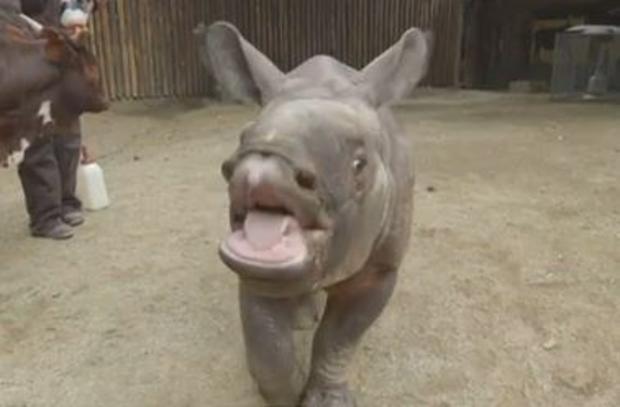Scientists hope "Frozen Zoo" will help save endangered species
Scientists at the San Diego Zoo Safari Park are looking at new ways to breathe life into critically endangered animals. They're collecting samples from thousands of creatures, including rhinos, teetering on the brink of extinction, reports CBS News correspondent John Blackstone.
Meet Chutti, a scampering baby rhino who was born on Thanksgiving. His name means "holiday" and he's one of 68 greater one-horned rhinos bred at Safari Park, increasing the numbers of this endangered species to around 3,000 worldwide.
But rhino keeper Jane Kennedy keeps close watch over one in particular, a northern white rhinoceros named Nola.
Nola is just one of five northern white rhinos left in the world.
"She's almost 41, so essentially think of her like a mid-80-year-old woman. She's at the end of her life," Kennedy said.
Rhinos are being driven to extinction in large part because of poaching. In 2014 in South Africa alone, 1,215 were killed for their horns. The horns are prized in some cultures, mistakenly believed to be aphrodisiacs and miracle cures.
"The horn is made out of keratin, the same thing as your fingernail," Kennedy said. "If rhino horn cured cancer, then all you'd have to do is chew on your fingernails and there would be no more cancer in the world."
The northern white rhino's best chance for avoiding extinction might be inside a vat of liquid nitrogen at Safari Park's "frozen zoo." It's the world's largest genetic bank with samples from some 10,000 animals, including 12 northern whites.
Barbara Durrant, director of reproductive physiology at the San Diego Zoo Institute for Conservation Research, said it's "certainly our hope" that the northern white rhino can be in the wild again.
"We think it's a possibility, yes," Durrant said.
That hope hangs on a futuristic technology. It's a complex procedure where skin cells become stem cells, which then become egg and sperm necessary for in-vitro fertilization. The embryo would be carried by a surrogate mom from a related species.
This has been done in a mouse, but it's never happened with the rhino, Durrant said, adding that it's a "moonshoot," but a "well-educated and calculated moonshot."
That calculation comes from a successful track record using less complex methods to help other endangered species reproduce, from giant pandas to California condors.
While some critics say the money should be spent on saving the animals from the wild, Durrant said people are already doing that.
"Our focus, our mission is to save these animals through science," Durrant said.
"What zoos need to focus on is improving the conditions for the animals who are already in their care, not pouring millions and millions of dollars into a futile effort to clone animals, for whom there is no natural habitat left on earth," said Brittany Peet, deputy director of captive animal law enforcement at PETA.
The Safari Park maintains their animals' well-being is paramount. Nola's health is carefully monitored. She needs regular pedicures and enjoys having her back scratched with a brush.
"The fact that we have all known and loved the northern white rhinos, it's a personal thing," Durrant said.
Despite successful breeding program, there are still few rhinos calves, so Chutti's playmate is a cow named Moo Moo Kitty. It's a friendship that wouldn't happen in the wild, but can cure some of the loneliness for an animal on the edge of extinction.
"If we don't do something as a human species, our grandchildren and great grandchildren will never see these animals," Kennedy.
